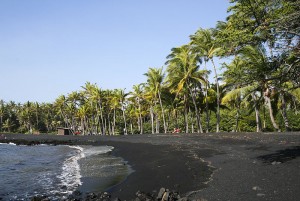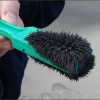Is Sand Magnetic?
Saying all sand is magnetic or non-magnetic would be virtually impossible, or frankly, inaccurate. Most sand is created from a natural process called weathering, which could take anywhere from hundreds or millions of years to occur. This process is essentially when the environmental elements breakdown minerals, rocks, and chemicals together over a certain period of time.
Where the sand is located effects how it forms and what types of materials form it. For instance, the composition of beach sand can be very different from the composition of desert sand. In many types of sand the main component is quartz. On tropical islands with white sand beaches, the main component could likely be calcium carbonate, usually from organic materials that have decomposed over time.
To sum it up, the types of sand on Earth and the components of each type are extremely diverse, so in order to determine if it’s magnetic requires knowing what’s in it, which can be difficult. Despite this, there is one type of sand that we know is usually magnetic -- black sand.
 "Diego Delso, Wikimedia Commons, License CC-BY-SA 3.0[/caption]
Obviously, black sand is sand that is dark or black in color. Most types of black sand are formed near a volcano and/or as a result of a volcanic eruption. Others are formed where there are heavy minerals. Each often contain a magnetic mineral called magnetite. Volcanic minerals and lava fragments commonly have magnetite in them. Magnetite is a type of iron oxide that is naturally occurring, and it is what makes black sand magnetic.
This type of sand can be found on many beaches in Hawaii, like Punaluu. But they are other places in the world that have black sand beaches. For example, New Zealand and Iceland have impressive stretches of black sands.
If you’re planning a vacation and want to visit one of these striking sights, bring a strong rare earth magnet and test the sands’ magnetism. It will likely be attracted to the magnet in the same way that iron filings are attracted. However, be careful. Because of its color, this sand gets much hotter than regular sand. Also, on some beaches that are protected, it is forbidden to try to take a large quantity of this sand home with you.
Photo by Tatters
"Diego Delso, Wikimedia Commons, License CC-BY-SA 3.0[/caption]
Obviously, black sand is sand that is dark or black in color. Most types of black sand are formed near a volcano and/or as a result of a volcanic eruption. Others are formed where there are heavy minerals. Each often contain a magnetic mineral called magnetite. Volcanic minerals and lava fragments commonly have magnetite in them. Magnetite is a type of iron oxide that is naturally occurring, and it is what makes black sand magnetic.
This type of sand can be found on many beaches in Hawaii, like Punaluu. But they are other places in the world that have black sand beaches. For example, New Zealand and Iceland have impressive stretches of black sands.
If you’re planning a vacation and want to visit one of these striking sights, bring a strong rare earth magnet and test the sands’ magnetism. It will likely be attracted to the magnet in the same way that iron filings are attracted. However, be careful. Because of its color, this sand gets much hotter than regular sand. Also, on some beaches that are protected, it is forbidden to try to take a large quantity of this sand home with you.
Photo by Tatters
What Is Black Sand?
[caption id="attachment_1281" align="alignnone" width="300"] "Diego Delso, Wikimedia Commons, License CC-BY-SA 3.0[/caption]
Obviously, black sand is sand that is dark or black in color. Most types of black sand are formed near a volcano and/or as a result of a volcanic eruption. Others are formed where there are heavy minerals. Each often contain a magnetic mineral called magnetite. Volcanic minerals and lava fragments commonly have magnetite in them. Magnetite is a type of iron oxide that is naturally occurring, and it is what makes black sand magnetic.
This type of sand can be found on many beaches in Hawaii, like Punaluu. But they are other places in the world that have black sand beaches. For example, New Zealand and Iceland have impressive stretches of black sands.
If you’re planning a vacation and want to visit one of these striking sights, bring a strong rare earth magnet and test the sands’ magnetism. It will likely be attracted to the magnet in the same way that iron filings are attracted. However, be careful. Because of its color, this sand gets much hotter than regular sand. Also, on some beaches that are protected, it is forbidden to try to take a large quantity of this sand home with you.
Photo by Tatters
"Diego Delso, Wikimedia Commons, License CC-BY-SA 3.0[/caption]
Obviously, black sand is sand that is dark or black in color. Most types of black sand are formed near a volcano and/or as a result of a volcanic eruption. Others are formed where there are heavy minerals. Each often contain a magnetic mineral called magnetite. Volcanic minerals and lava fragments commonly have magnetite in them. Magnetite is a type of iron oxide that is naturally occurring, and it is what makes black sand magnetic.
This type of sand can be found on many beaches in Hawaii, like Punaluu. But they are other places in the world that have black sand beaches. For example, New Zealand and Iceland have impressive stretches of black sands.
If you’re planning a vacation and want to visit one of these striking sights, bring a strong rare earth magnet and test the sands’ magnetism. It will likely be attracted to the magnet in the same way that iron filings are attracted. However, be careful. Because of its color, this sand gets much hotter than regular sand. Also, on some beaches that are protected, it is forbidden to try to take a large quantity of this sand home with you.
Photo by Tatters

